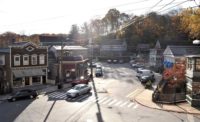Centennial Boulevard Reconstruction
Colorado Springs
Best Project
Owner: City of Colorado Springs
Lead Design Firm: Wilson & Co., Engineers and Architects
General Contractor: Kiewit Infrastructure Co.
Structural/Civil Engineer: Wilson & Co., Engineers and Architects
Surveying & Landscape Design: NV5
Geotechnical Engineer: Terracon
In this much-needed project, seven lane-miles of heavily traveled Centennial Boulevard in Colorado Springs were fully reconstructed to correct road grades, improve drainage and provide a base for future maintenance. An additional four lane-miles didn’t need complete rebuilding but were milled and received an asphalt overlay.
The $8.7-million project also filled gaps in the sidewalks and added three miles to the city’s buffered bike-lane network. In one big improvement, crews removed several center medians between Chesham Circle and Windmill Avenue that previously forced residents to make a U-turns into or out of their neighborhoods. Construction also included three beautifully landscaped medians.
The boulevard is a principal artery, connecting heavy truck traffic to a regional mining operation. The project is the first of three major reconstructions made possible by funds from the Pikes Peak Rural Transportation Authority. Many of the benefits lie below ground, but above ground, motorists are experiencing a much smoother ride, and pedestrians have noticed improvements to curb ramps for wheelchairs and a continuous sidewalk on both sides of the street.
Even small projects can be filled with challenges. In this one, the key issue was working around the many shallow underground utilities. While probing them, the contractor discovered electrical vaults full of water, a saturated subgrade and poor soil. To address these problems, the team redesigned portions of the job, and the city approved numerous construction variances. An extensive pothole-digging operation—more than 1,800 holes—helped the team develop a 3D model of the utilities. That allowed adjustments to the project and kept utilities from having to be lowered entirely. In more than 41,000 man-hours of work, the team had zero OSHA recordables and zero lost-time accidents.
Working in close partnership and emphasizing teamwork and communication, the city, the contractor and the designer finished the planned 440-day project 10 days early. The result is a rebuilt segment of a major street that improves safety, provides a more enjoyable drive and offers benefits to bicyclists and pedestrians as well as motorists.
Related Article: ENR Mountain States Best Projects 2018: A Healthy Mix of Public and Private Projects Garner This Year's Top Awards






Post a comment to this article
Report Abusive Comment